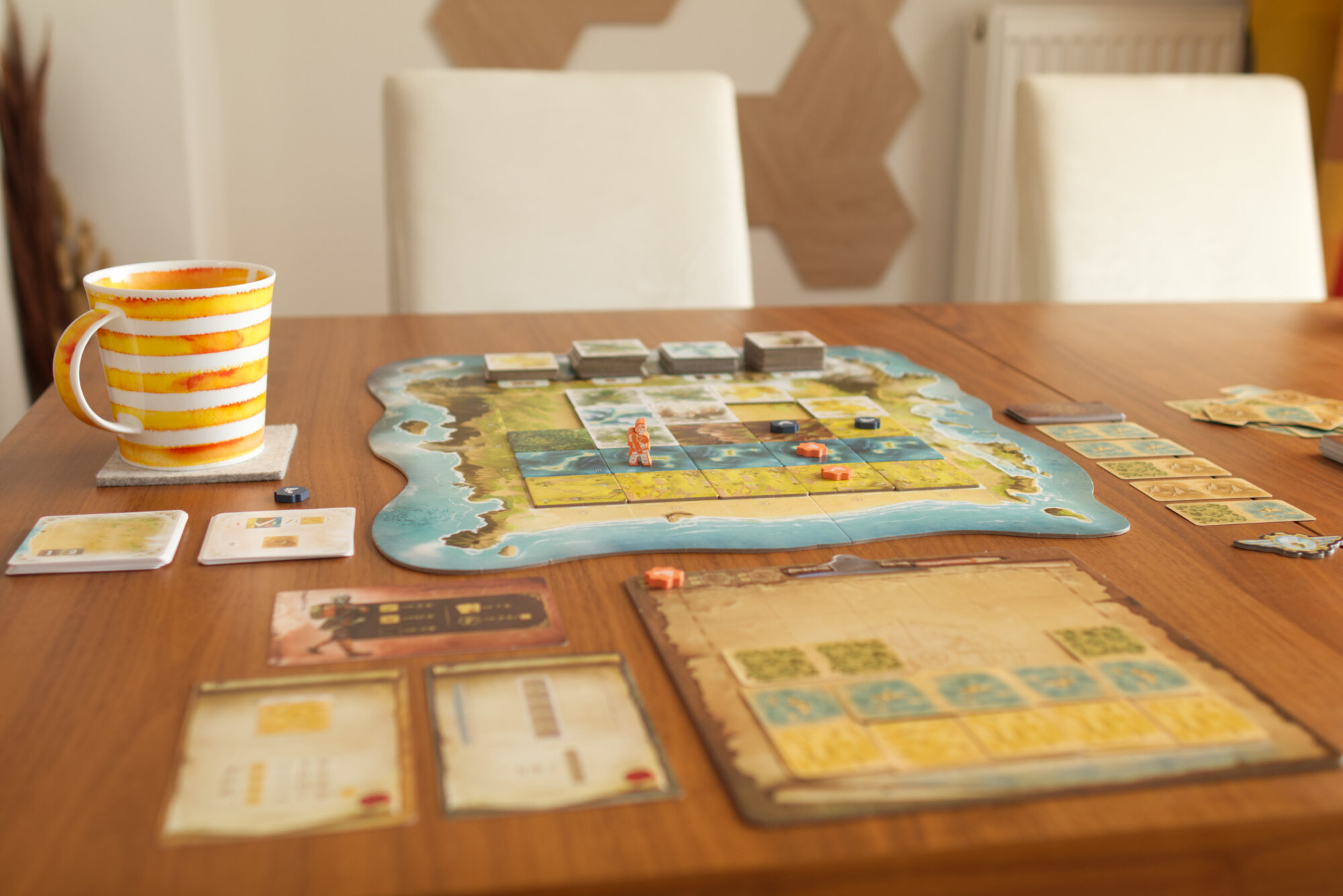I’ve been enjoying publisher Sit Down!‘s output for a while now. They first came on my radar with 2017’s collaborative no-speaking supermarket heist Magic Maze and since then I’ve both enjoyed my plays of competitive minesweeper-style Tiwanaku and the gorgeous, nature photography themed Redwood. While definitely more on the lighter end of the spectrum of what I usually play, both Tiwanaku and Redwood had this little “something” that made them endearing and their biggest negative was that I had a hard time finding someone who wanted to play them with me. I’m all up for multi-hour games like John Company 2nd Edition or Hegemony, but sometimes I’m in the mood for something easy going to switch the brain off.
When I heard of the basic premise of Maps of Misterra, I was interested in checking it out before I had even seen a picture of it!
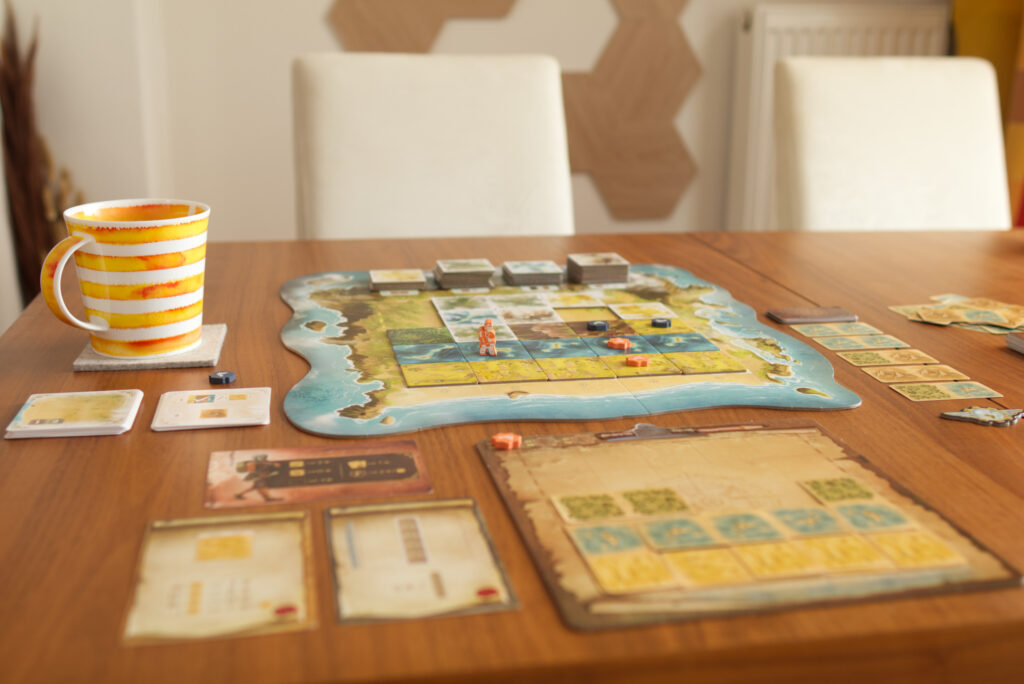
Setup
In Maps of Misterra, players are competing cartographers on a newly discovered island that are in a constant struggle between mapping accurately what they find on the island and creating a map that is … let’s say … more to the liking of their employers. Great start, right? The production of Maps of Misterra also immediately creates a positive vibe as it comes in a rather compact box, has a good insert and lovely illustrated components – the wooden pieces are even screen printed!

For setup, unfold the irregularly shaped main board and place terrain tiles onto the respective supply spots. Give each player a player board, meeple, 3 tokens that are used to claim terrain plus two sponsor cards which represent end game scoring criteria. These vary from getting points for a large amount of one type of terrain to certain configurations of terrain and various other things.

Slightly annoyingly, the draw deck of domino-style sketch cards needs to be changed depending on player count by removing cards for a higher player count (e.g. remove all 3+ cards when playing with only two players). Overall, setup isn’t bad and rather quickly done.
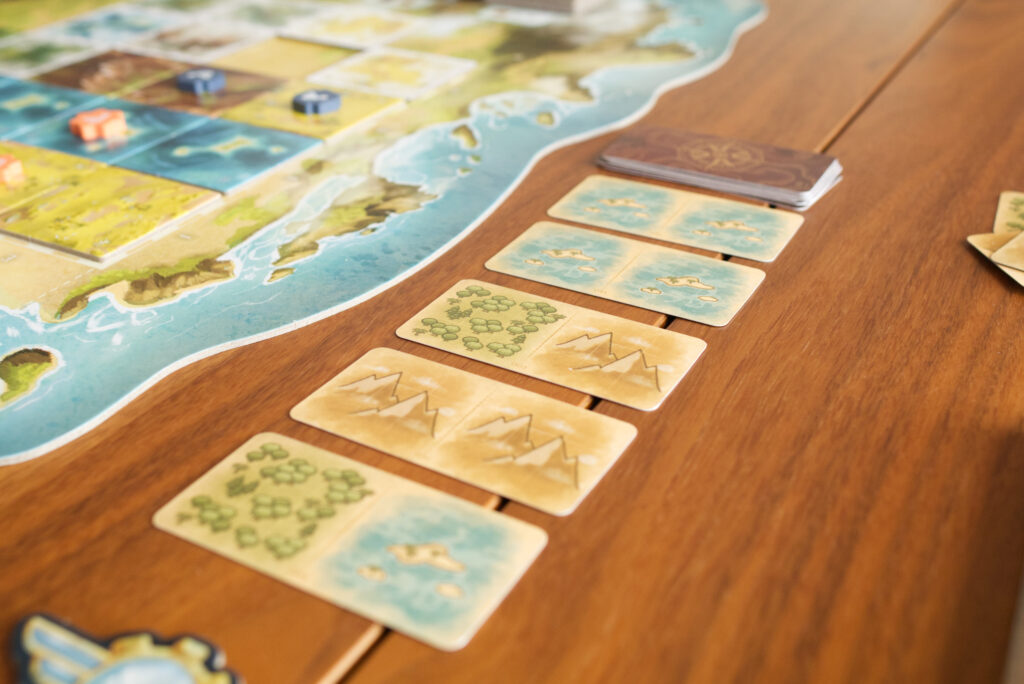
The Turn
A player’s turn consists of two “half-days”, each following the same order: first the player moves their meeple to a neighbouring space (or stays where they are), then chooses a sketch card from the common display, and then either places it on their player board to further sketch the island – or – claim the terrain they are standing on. There are two twists here: one, based on the terrain the player is standing on, certain effects come into play. If they stand on a mountain, they can sketch places farther away. If they move onto a steppe, they can move an additional square. If on a lagoon, they can exchange one card in the common display with a new one from the deck. And if they stand on a jungle, they are not allowed to sketch the island that half-day and only optionally claim the terrain.
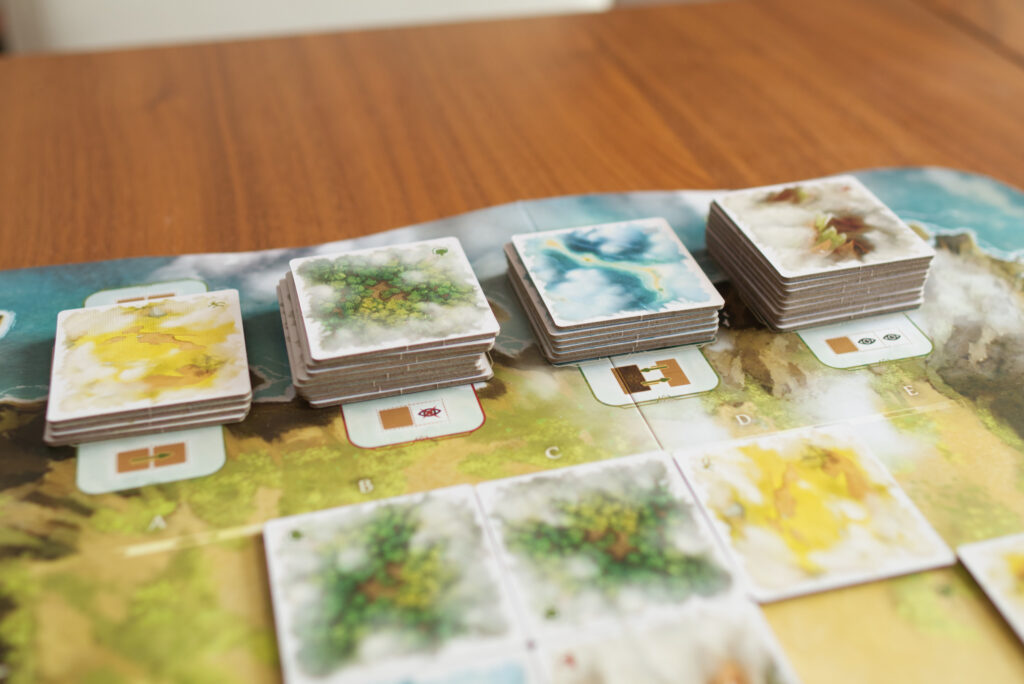
For the other twist, I’ll first have to tell you how sketching works. In the end it’s rather simple: take the card from the common display and place it on your player board next to where your meeple is standing on the main board. If no terrain tile exists on the respective square on the island, place the type of terrain shown on the sketch card onto the main board with the misty side face up. If however there’s already a tile on the main board, either confirm the terrain type if it the tile matches that on your sketch by flipping it from the misty to the normal side or replace the terrain tile with the misty side of the new terrain type. Or in other words: as long as the tile is misty-side up, it can still change, and if it’s normal side up because on two subsequent occasions the same thing was sketched, it’s locked in for the rest of the game.

Coming back to the second twist: the effects of the terrain as described above are active regardless of whether a square has already been confirmed or is still uncertain. So a player can play a sketch card, change the terrain type of a neighbouring square, then move on that square with their second half-day and then immediately use the effect of the terrain!
Finally, instead of playing a sketch card on their board, a player can discard it and instead claim the region of matching terrain they are currently standing on. Each such region can only be claimed by one player and each player can only claim one region of each type up to a maximum of three groups. That’s pretty much it. The rules for movement and how sketching work are rather simple and easy to learn.
End of Game
The game ends when either the last square of the main board has a confirmed terrain tile on it or one player has filled all squares on their personal sketch. All players then get points for every square on their sketch that matches the real island, lose points for every square on their sketch that isn’t filled, and gain points for the two sponsor cards they received during setup. In an advanced mode, players additionally get points if a whole row or column of their sketch matches the island perfectly.
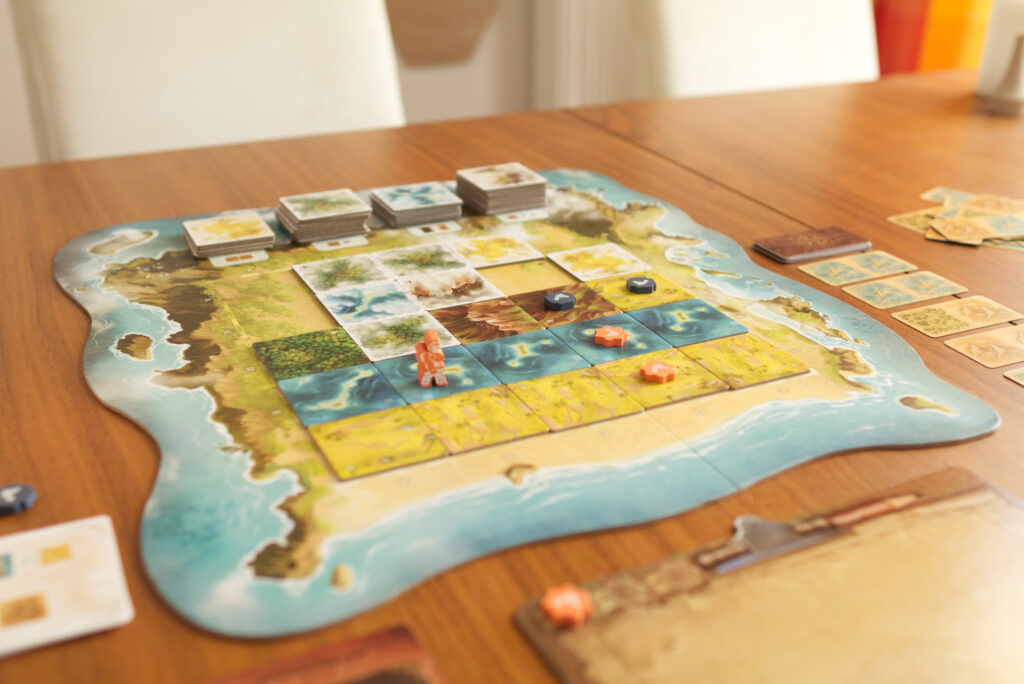
Solo Mode
Maps of Misterra comes with a dedicated solo mode in which the player competes against an automa-deck driven opponent. It’s rather simple and quick to perform: reveal the next card from the automa deck which shows two locations on the island. Place on these squares the terrain types as indicated on the newly revealed top card of the automa draw deck or confirm the existing misty tiles in those locations. Do that two times, then discard all remaining sketch cards in the common display. At three times in the game, the automa claims the biggest region that it still can claim, and that’s basically it.
The automa works, but it’s a bit of a shame that it lacks the most interesting part of Maps of Misterria: positional play. The automa just sketches in random locations where human players are forced to walk somewhere before they can sketch their. This removes a huge limitation and also point of interaction as in regular play a well placed jungle can block your opponent or a suddenly appearing mountain may allow for further away sketching.
Overall I would describe it as sufficient, workable, but nothing to get excited about. I’ve played against the automa a couple of times and had a good time, but it’s not something I really crave for to return to.

Conclusion
Unfortunately, Maps of Misterria didn’t quite stick the landing for me. It has a great premise, the production is really nice, and there were some fun moments of me trailing a friend of mine, negating all the forests he had sketched and turning them into mountains. But it feels like a game that had great potential and then was limited to being a family-weight intermezzo. When things clicked, I found myself wishing the island would be bigger and there was more depth to the game. When things didn’t, it felt trivial, unbalanced, and lopsided.
Take for example the sponsor cards: the idea of having conflicting interests between what your sponsors want and what the island is really like is great, but sketching accurately just produces too many points. It’s rarely a viable option to ignore reality in favour of a better sketch because you’ll lose too many points by being inaccurate. Thematically, the sponsors also feel underutilised. They are just abstract cards one receives during setup and scores during end game, but they could have been actual characters with illustrations that show up mid game and tell players what they want. It could have been a necessity to follow their requests to fuel your further expeditions, but instead the sponsors fell more like a side-objective. It is much more important to stay accurate and switch terrain in a way that the opponent’s sketch becomes invalid. We also found them unbalanced and some being easier than others.
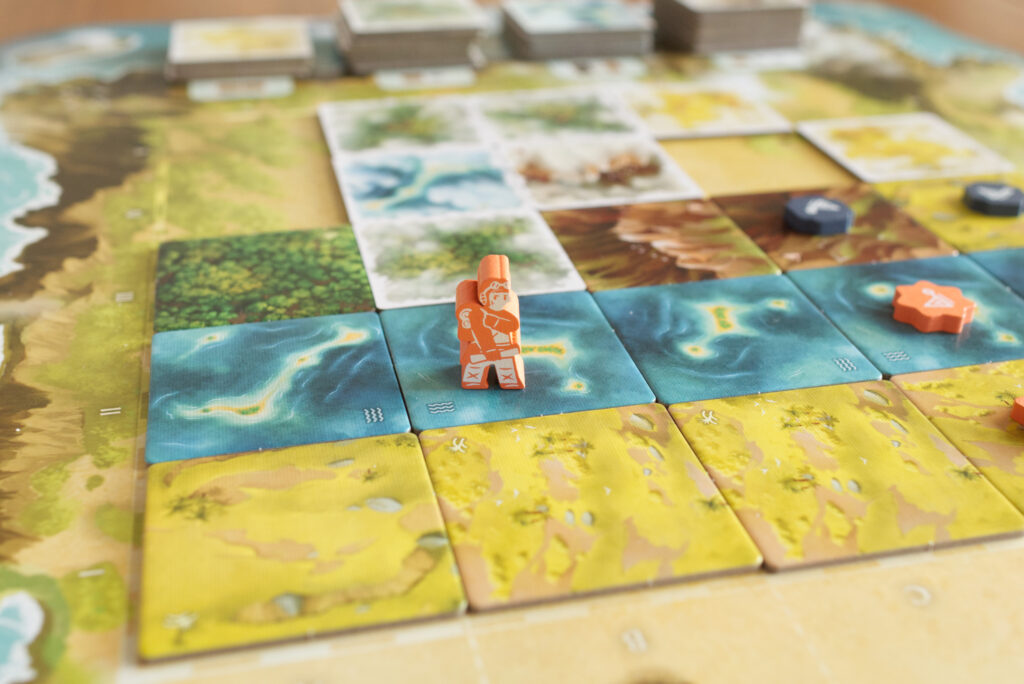
Claiming terrain on the other hand adds a nice piece of extra tension with players rushing to claim good spots before they are gone and others trying to make opposing claims score less by limiting the extend of regions. What might be a promisingly large forest region can quickly turn into a single forest surrounded by mountains if claimed too quickly.
Overall, I had a good time with Maps of Misterra. I would play it again if someone suggests it, but the point is I don’t think any of my friends would do so. It’s a lovely production with great premise that is missing that certain “je ne sais quoi” to make it stick out from the flood of new games that come out each year. I’m fond of it based on its theme and artwork, but that’s not enough to get it to the table unfortunately. It would be interesting to see how it would work with younger players in a family setting. My suspicion is that it’s a bit too complex/thinky and “take that” for that scenario. Either way, it comes down to a simple question: why should one play this game when there are many, many others to choose from?
